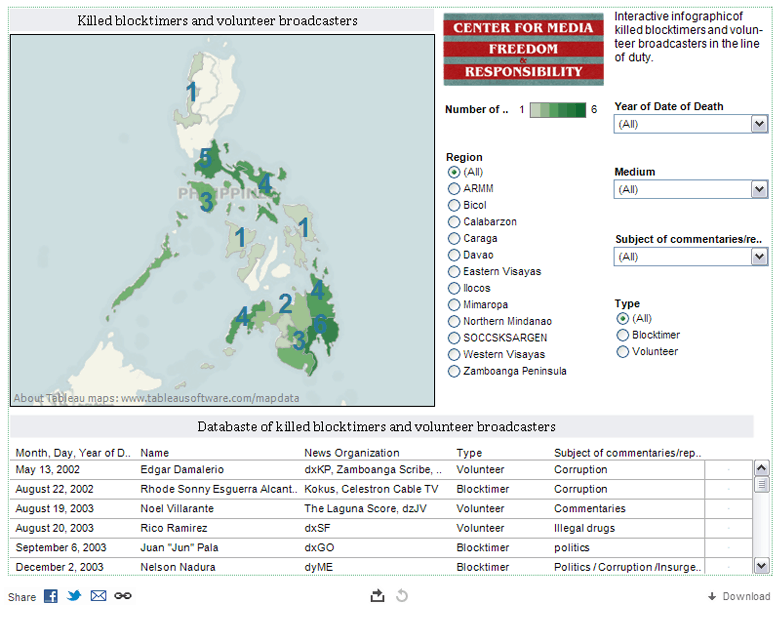"Blocktiming" is a practice in which individuals or groups purchase TV or radio airtime for programs that they "sell" to sponsors; about 22% of the journalists killed for their work in the Philippines since 1986 involve blocktimers.
(CMFR/IFEX) – Just two days into the year 2013, a radio anchor was killed in the city of San Pablo, Laguna province. The victim, city councilor and dentist Edgardo “Egay” Adajar, hosted a “blocktime” program supposedly funded by the City Information Office. The program usually focused on illegal gambling and the drug trade in the city.
About 22 percent of the journalists killed for their work since 1986 involve so-called blocktimers. Since 1986, CMFR has recorded 129 cases of work-related killings of journalists and media workers in the Philippines. Adajar was the 28th blocktimer killed in the Philippines since 1986.
“Blocktiming” is a practice in which individuals or groups purchase TV or radio airtime for programs that they “sell” to sponsors.
Trends
The first recorded case of the killing of a blocktimer happened in August 2002, also in San Pablo City, Laguna. Rhode Sonny Alcantara, publisher of the weekly Kokus and host of blocktime TV program Quo Vadis San Pablo, was on his way to work when an unidentified man shot him in the head.
Many believed that Alcantara’s scathing criticism of a local politician allegedly involved in corruption motivated his murder. One of his exposes involved the supposed illegal lease of government-owned land to a shopping mall in San Pablo City, Laguna.
Starting in 2002, CMFR recorded at least one work-related killing of a blocktimer each year. A total of 57 individuals – excluding the 32 victims of the Ampatuan Massacre – were killed from January 2002 to January 2013; almost 50 percent had blocktime programs on radio and television.
The highest number of blocktimers killed in a year was five, which happened in 2006. These included the killing of Rolly Cañete, Fernando Batul, couple George and Maricel Vigo, and Armando “Rachman” Pace.
The victims were mostly blocktiming on radio. Only Alcantara had been actively blocktiming on television before he was killed. Adajar had produced and handled a talk show program in a local TV channel in the late 1990s.
Part-time media
These blocktimers had other jobs. Some published and/or edited their own newspapers, while others wrote opinion columns. A few worked for non-governmental organizations and advocacy groups. Others were allegedly spokespersons, political advisers, or publicists of politicians. Or, they themselves were the politicos.
Some of these politicos-blocktimers were previously employed as reporters/correspondents of local news organizations before they decided to run for public office. One example was Aldion Layao.
Veteran radio broadcaster and barangay chairman Layao started his broadcasting work in 1986 as a volunteer reporter for dxZM of the University of Mindanao. Before running for elections in 2010, Layao was a reporter for RGMA Davao City. In an interview with CMFR his wife said that Layao had been known for his public service work while in radio. He had to stop broadcasting in early 2010 when he ran for the chairmanship of the barangay council; he however returned to broadcasting through the blocktime program “Kapitan Aldion Layao” over dxRP in 2011 and 2012.
Advocates
Some of the blocktimers killed in the past ten years were advocates of good governance, human rights, and environment protection. They criticized local politicians, government officials, and even businessmen for allowing illegal gambling, illegal logging, and other human rights violations to thrive in their communities.
Before starting her career as a radio anchor and columnist in 2000, Marlene Esperat was employed in the Department of Agriculture in Region XII which had been the subject of her exposes. In the 1990s, Esperat discovered misappropriation of the funds by some local agriculture officials. She became a resident ombudsman at the Agriculture department. She had administrative and criminal cases against allegedly corrupt government officials, among whom the alleged masterminds behind her 24 March 2005 murder – Osmeña Montañer and Estrella Sabay.
The gunman and his accomplices have been convicted by a local court in Cebu in 2006. The alleged masterminds are currently facing murder charges in a court in Makati City.
Volunteer Broadcasters
Aside from blocktimers, seven “volunteer” reporters have been killed in the Philippines. One such case is that of Edgar Damalerio in Pagadian City, Zamboanga province. (Volunteer reporters do not get any salary from their media organizations. However, there have been instances in which volunteer reporters were eventually hired as regular employees.)
Damalerio was the managing editor of the weekly newspaper Zamboanga Scribe and a correspondent for the Mindanao Gold Star. He hosted “Enkwentro” (Encounter), a program aired over the local cable TV channel. He was also a commentator for radio station dxKP.
Damalerio was known for exposing the illegal activities of local politicians, and police and military officials in his province. Like Esperat, he filed cases against these officials. A few months before he was killed in May 2002, Damalerio had reported the allegedly anomalous purchase of passenger jeeps by the Pagadian City government.
Fighting impunity
Overall, there had only been conviction in 10 work-related killings of journalists/media workers since 1986. Four of these 10 cases involved blocktimers and volunteer broadcasters – Esperat, Cantoneros, Pace and Damalerio.
The killing of other blocktimers and volunteer broadcasters are unsolved – 13 cases are in court, four have resulted in acquittal/dismissal, two have been archived temporarily, and 13 left “cold” at the investigation level.



